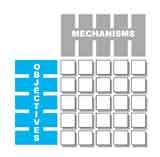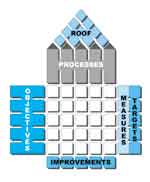How QFD works
 At
its simplest, QFD is a matrix: a series of rows and columns (see
picture on the right). Each row reflects a clear business objective,
and each column reflects a separate mechanism, e.g. function,
unit, department or process of that business.
At
its simplest, QFD is a matrix: a series of rows and columns (see
picture on the right). Each row reflects a clear business objective,
and each column reflects a separate mechanism, e.g. function,
unit, department or process of that business.
![]() The cells represent the capacity for each
business mechanism to influence the attainment of each objective.
Developing the framework for the matrix provides an opportunity
for the management team to reconsider the organisation's mission,
its logic, and its operating structure.
The cells represent the capacity for each
business mechanism to influence the attainment of each objective.
Developing the framework for the matrix provides an opportunity
for the management team to reconsider the organisation's mission,
its logic, and its operating structure.
![]() The quality of insight that QFD can provide
depends greatly on the care with which the 'mechanisms' are defined.
The 'mechanisms' (columns of the QFD matrix) are the means by
which the organisation fulfils its goals - they are logical subdivisions
of the organisation. Some ways of dividing up the business provide
a richer depth of understanding within QFD than others, and in
practice the most useful models tend to be ones based on business
processes. For some companies, QFD has caused them to fundamentally
rethink how they organise themselves.
The quality of insight that QFD can provide
depends greatly on the care with which the 'mechanisms' are defined.
The 'mechanisms' (columns of the QFD matrix) are the means by
which the organisation fulfils its goals - they are logical subdivisions
of the organisation. Some ways of dividing up the business provide
a richer depth of understanding within QFD than others, and in
practice the most useful models tend to be ones based on business
processes. For some companies, QFD has caused them to fundamentally
rethink how they organise themselves.
![]() By discussing each cell of the resulting
matrix, the managers develop a complete understanding of how
the business must work as a whole if it is to succeed. This provides
insight as to how the processes could exploit their potential
in new and innovative ways, and, equally importantly, how they
may have adverse effects that need to be controlled.
By discussing each cell of the resulting
matrix, the managers develop a complete understanding of how
the business must work as a whole if it is to succeed. This provides
insight as to how the processes could exploit their potential
in new and innovative ways, and, equally importantly, how they
may have adverse effects that need to be controlled.
![]() Through a simple mathematical relationship,
QFD provides a means of ranking the objectives, and prioritising
improvement of the processes. Teams responsible for managing
each process can then draw up additional, more detailed, QFDs,
to think through how their process can be creatively developed
to best fulfil the expectations now placed upon it.
Through a simple mathematical relationship,
QFD provides a means of ranking the objectives, and prioritising
improvement of the processes. Teams responsible for managing
each process can then draw up additional, more detailed, QFDs,
to think through how their process can be creatively developed
to best fulfil the expectations now placed upon it.

![]() By further developing the basic
diagram, QFD also provides for the management team to think through
their communication and reporting needs. A triangular, half-matrix
on top of the main QFD diagram (shown right) provides an opportunity
to look at the interactions between each of the business processes
(or departments or business groups, depending on the organisational
model chosen) and to highlight the extent to which they are likely
to work in harmony or conflict. This helps those who manage those
processes to think through the level of communication they need
to arrange between them.
By further developing the basic
diagram, QFD also provides for the management team to think through
their communication and reporting needs. A triangular, half-matrix
on top of the main QFD diagram (shown right) provides an opportunity
to look at the interactions between each of the business processes
(or departments or business groups, depending on the organisational
model chosen) and to highlight the extent to which they are likely
to work in harmony or conflict. This helps those who manage those
processes to think through the level of communication they need
to arrange between them.
![]() Proceed to: Benefits
of QFD; Applications; Links
to other tools, or return to QFD overview.
Proceed to: Benefits
of QFD; Applications; Links
to other tools, or return to QFD overview.
© Tesseract Management Systems Ltd 2003
(click below for an oversight)
QFD Transforms performance by 140%
(case study)
Case studies of success: transforming organisational performance through QFD
Managing by Design
- a handbook of
Systematic Mgt.
(purchase on line)
QFD: The mechanics explained
(click-through tutorial)
Testimonials on QFD